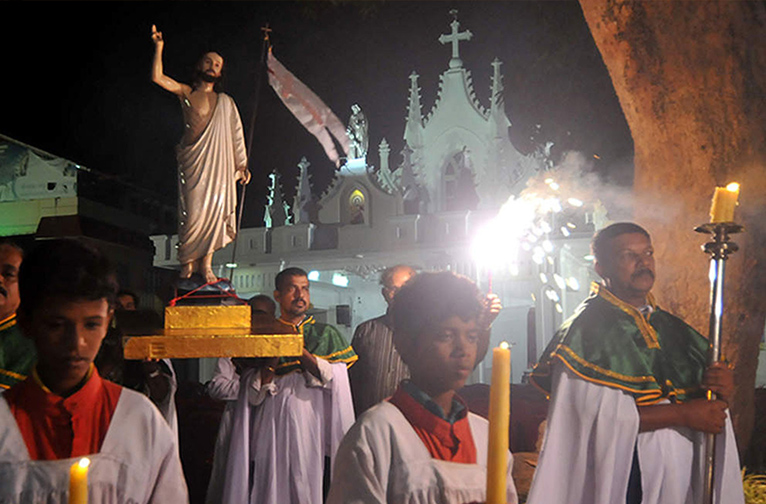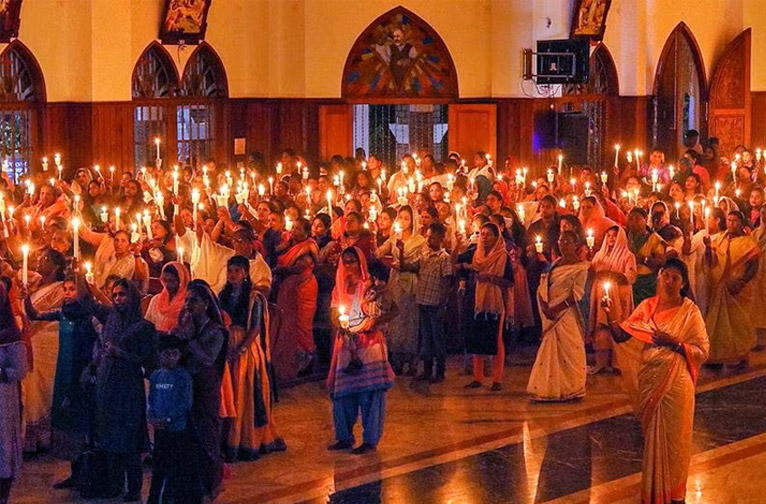Embrace this excellent opportunity to discover the cultural diversity of India’s take on a deep-rooted Western religious festival.
The advent of colonial rule in India, marked by the presence of the Portuguese, the French, the Dutch and the English, has left its considerable impress on some of India’s most favoured holiday destinations. Leading the charge are, of course, the states of Goa and Kerala who were amongst the early ones to embrace Christianity.
Easter, a time of festive cheer follows the sorrowful 40- day period of Lent which is marked by prayer, and fasting in remembrance of the events leading up to and including the death of Jesus Christ. The Easter story revolves around the story of Jesus, his death on the cross at the hands of the Roman soldiers on Good Friday — and the hope and glory of the resurrection of Christ on Easter Sunday. It's a joyful celebration across the entire Christian world.
Holy Week begins on Palm Sunday and ends with Easter Sunday. Palm Sunday, for the uninitiated, in the Christian tradition, is the first day of Holy Week and the Sunday before Easter. It commemorates the triumphal entry of Jesus Christ into Jerusalem during the last week of His life. The great throngs lining the streets welcome him with cries of “Hossana”, a heartfelt cry of deep adoration for the one who will save them.
Hot cross buns, colourful Easter eggs and the Easter bunny have all become intertwined with the joyful day of Easter and you are bound to encounter the fun of sharing all this and more with your loved ones.
GOA
Deeply embedded with Portuguese culture Goa has a fabulous array of churches to explore and attend traditional Easter services. Old Goa is home to several iconic centuries old churches which draw huge crowds on Easter Sunday. The joyful festivities are marked by elaborate decorations of the churches with flowers and fairy lights.
Join devotees for the Vigil and Easter masses at Se Cathedral or Basilica of Bom Jesus Church. Visitors also wend their way to the beautifully decorated Church of the Holy Spirit and St. Andrew's Church. Devotees also come for viewings of the ‘Last Supper’ a play organized at Our Lady of Grace Church in South Goa on Thursday, the day before Good Friday.
Good Friday celebrations are attended in churches scattered all across town. The 'three Hours’ Agony prayer' is offered from 12:00 noon to 3:00 pm in remembrance of Christ’s agonized time spent in the Garden of Gethsemane on the Mount of Olives, before the Roman soldiers arrested him. Fonna Kacheri, a unique Goan tradition, features an ensemble of western and Indian classical music performances in a fusion of deep harmony carried out in various churches.
On the Saturday before Easter Sunday a unique ritual involving the burning of an effigy of Judas Iscariot is held in memory of his betrayal of Christ. One of Christ’s 12 beloved disciples Judas is said to have betrayed him to Roman soldiers for 30 pieces of silver.
In Panjim let your footsteps lead you to the beautiful The Church of Our Lady of the Immaculate Conception awash with the faithful from all over the city and along with many visitors. This is one of the most popular venues for the celebrations. What’s quite unique is the mass here is conducted in the regional Konkani language, and not English as it is done in other churches.
The mass is followed up by an elaborate procession of the ritual of the Way of the Cross, a replay of the events that led to Jesus’ crucifixion at Calvary. The ceremony involves a massive cross being brought out from the church then, along with an image of Jesus, being carried through the streets marking the 14 stations on Christ's last journey to the hill of Calvary from Pontius Pilate’s palace. Devotees follow behind carrying candles and singing hymns; the cross is then returned by the clergymen to the church.
Easter egg hunts are accompanied by much joy and laughter. While kids and adults both enjoy the fun of decorating and exchanging Easter eggs, not many are aware of a lovely Latin American ritual surrounding them. It appears that the hollowed-out eggs, locally known as Cascarons, are filled with confetti. In the course of the celebrations these beautifully decorated eggs are broken over the heads of the near and dear to unleash a shower of confetti and much laughter.
The traditional Easter feast is one of the major highlights of the line-up of events for the festival. Tuck into traditional treats like the Portuguese-inspired Sorpotel, Xacuti, Sannas, Vindaloo, Bebinca, Bolinhas, and Dodol. Hot cross buns are traditional favourites to gobble up on Maundy Thursday, the fifth day of the holy week, which commemorates the Last Supper of Jesus.
Kerala
The Christian legacy of ‘God’s Own Country’ dates back to the arrival of St Thomas, the disciple of Jesus Christ, on Kerala’s shores back in 52 CE. The early days of his sojourn here saw the establishment by him of the Syro-Malabar Church in Kodungallur.
Traditional midnight mass ceremonies are held across churches scattered across Kerala. Elaborate rituals mark the celebrations at Syro-Malabar Church in Kakkanad, Kochi, Joseph’s Metropolitan Cathedral in Palayam, Thiruvananthapuram, Holy Family Church at Padathukadavu in Kozhikode, Malayattoor’s Kurisumudi Church and many more.
The 40 days of Lent, a period of fasting and prayer, are a run-up to the Easter Holy Week. The austerities of these 40 days are reflective of the days Christ spent in solitude in the desert, repelling the temptations that Satan put before him again and again. Holy Week marks the story of Jesus Christ’s triumphant entry into Jerusalem, his agonising death on the cross and his amazing resurrection on Easter Sunday, when he defeated death.
Palm Sunday, marking Christ’s entry into Jerusalem, is celebrated in Kerala with devotees participating in a ceremony called Kuruthola Perunnal by waving the tender leaves of coconut palm as a sign of welcome to the saviour.
On Maundy Thursday or Pesaha Vyazham, Christian families across Kerala ritually cut the sacred Pesaha Appam (unleavened bread), the honours being done by the elder in the family who then distributes it, along with a glass of Peseha Paalu, to everyone. The ritual memorialises the Holy Sacrament and the body and blood of Jesus Christ. The ceremony is representative of Christ’s 'Last Supper’ which he shared with his 12 disciples including Judas, who would betray him to the Romans.
Good Friday, the day Christ was crucified, is a solemn day for Kerela’s Christian community and marked as a day of ritual mourning. Fasting and time spent in the church in reflection in the morning involves another small ritual, which is the drinking of a little kaipuneeru a bitter combination of juice of panal tree leaves and vinegar. It represents the bitter cup offered to Jesus by the soldiers before his crucifixion. Symbolically the bitter cup was filled with the eternal and unchangeable wrath of God against man’s sins, which Christ found hard to swallow. The washing of the feet of 12 people commemorates Christ's act of the washing of his disciples' feet.


On the Saturday before Easter Sunday the community spends time in quiet vigil (as if at Christ’s tomb), cleaning their homes in preparation of his promise that he will overcome death and return. Holy water is sprinkled to keep everything pure and ready for him. Late on Saturday night everyone heads for the evening mass after which the fasting of Lent is broken by a lavish feast.
New born babies are baptised during the week after Easter Sunday till the coming Sunday. This day also marks the day when a risen Christ appears before Thomas, his disciple who doubts whether he has risen from the grave. It is known as St Thomas Sunday.
Traditional eats prepared during Kerala’s Easter celebrations include Thamukku Nercha a sweet dish made of jaggery, cooked rice, grated coconut and banana served on Palm Sunday in church. Kozhukatta is made of sweetened grated coconut wrapped in a rice flour pancake.
The Easter celebrations offer a fantastic window to Kerala’s journey in Christianity which dates back to the 52 CE, which marked the entry of the religion in India for the very first time. The cultural richness of that legacy is a mind-blowing experience played out in its depictions of the Easter story.